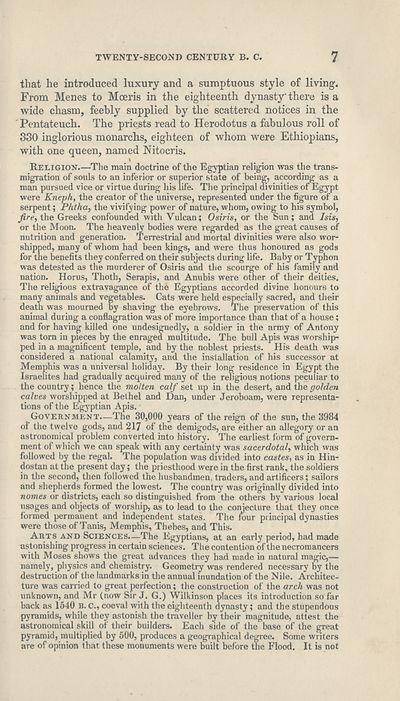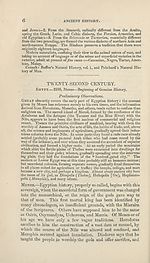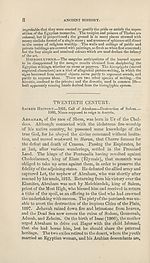Download files
Complete book:
Individual page:
Thumbnail gallery: Grid view | List view

TWENTY-SECOND CENTURY B. C.
7
that he introduced luxury and a sumptuous style of living.
From Menes to Moeris in the eighteenth dynasty' there is a
wide chasm, feebly supplied by the scattered notices in the
Pentateuch. The priests read to Herodotus a fabulous roll of
330 inglorious monarchs, eighteen of whom were Ethiopians,
with one queen, named Nitocris.
Religion.—The main doctrine of the Egyptian religion was the trans¬
migration of souls to an inferior or superior state of being, according as a
man pursued vice or virtue during his life. The principal divinities of Egypt
were Kneph, the creator of the universe, represented under the figure of a
serpent; Phtha, the vivifying power of nature, whom, owing to his symbol,
fire, the Greeks confounded with Vulcan; Osiris, or the Sun; and Isis,
or the Moon. The heavenly bodies were regarded as the great causes of
nutrition and generation. Terrestrial and mortal divinities were also wor¬
shipped, many of whom had been kings, and were thus honoured as gods
for the benefits they conferred on their subjects during life. Baby or Typhon
was detested as the murderer of Osiris and the scourge of his family and
nation. Horus, Thoth, Serapis, and Anubis were other of their deities.
The religions extravagance of the Egyptians accorded divine honours to
many animals and vegetables. Cats were held especially sacred, and their
death was mourned by shaving the eyebrows. The preservation of this
animal during a conflagration was of more importance than that of a house;
and for having killed one undesignedly, a soldier in the army of Antony
was tom in pieces by the enraged multitude. The bull Apis was worship¬
ped in a magnificent temple, and by the noblest priests. His death was
considered a national calamity, and the installation of his successor at
Memphis was a universal holiday. By their long residence in Egypt the
Israelites had gradually acquired many of the religious notions peculiar to
the country; hence the molten calf set up in the desert, and the golden
calves worshipped at Bethel and Dan, under Jeroboam, were representa¬
tions of the Egyptian Apis.
Goveunment—The 30,000 years of the reign of the sun, the 3984
of the twelve gods, and 217 of the demigods, are either an allegory or an
astronomical problem converted into history. The earliest form of govern¬
ment of which we can speak with any certainty was sacerdotal, which was
followed by the regal. The population was divided into castes, as in Hin-
dostan at the present day; the priesthood were in the first rank, the soldiers
in the second, then followed the husbandmen, traders, and artificers; sailors
and shepherds formed the lowest. The country was originally divided into
names or districts, each so distinguished from the others by various local
usages and objects of worship, as to lead to the conjecture that they once
formed permanent and independent states. The four principal dynasties
were those of Tanis, Memphis, Thebes, and This.
Arts and Sciences.—The Egyptians, at an early period, had made
astonishing progress in certain sciences. The contention of the necromancers
with Moses shows the great advances they had made in natural magic,—
namely, physics and chemistry. Geometry was rendered necessary by the
destruction of the landmarks in the annual inundation of the Nile. Architec¬
ture was carried to great perfection; the construction of the arch was not
unknown, and Mr (now Sir J. G.) Wilkinson places its introduction so far
back as 1540 B. C., coeval with the eighteenth dynasty; and the stupendous
pyramids, while they astonish the traveller by their magnitude, attest the
astronomical skill of their builders. Each side of the base of the great
pyramid, multiplied by 500, produces a geographical degree. Some writers
are of opinion that these monuments were built before the Flood. It is not
7
that he introduced luxury and a sumptuous style of living.
From Menes to Moeris in the eighteenth dynasty' there is a
wide chasm, feebly supplied by the scattered notices in the
Pentateuch. The priests read to Herodotus a fabulous roll of
330 inglorious monarchs, eighteen of whom were Ethiopians,
with one queen, named Nitocris.
Religion.—The main doctrine of the Egyptian religion was the trans¬
migration of souls to an inferior or superior state of being, according as a
man pursued vice or virtue during his life. The principal divinities of Egypt
were Kneph, the creator of the universe, represented under the figure of a
serpent; Phtha, the vivifying power of nature, whom, owing to his symbol,
fire, the Greeks confounded with Vulcan; Osiris, or the Sun; and Isis,
or the Moon. The heavenly bodies were regarded as the great causes of
nutrition and generation. Terrestrial and mortal divinities were also wor¬
shipped, many of whom had been kings, and were thus honoured as gods
for the benefits they conferred on their subjects during life. Baby or Typhon
was detested as the murderer of Osiris and the scourge of his family and
nation. Horus, Thoth, Serapis, and Anubis were other of their deities.
The religions extravagance of the Egyptians accorded divine honours to
many animals and vegetables. Cats were held especially sacred, and their
death was mourned by shaving the eyebrows. The preservation of this
animal during a conflagration was of more importance than that of a house;
and for having killed one undesignedly, a soldier in the army of Antony
was tom in pieces by the enraged multitude. The bull Apis was worship¬
ped in a magnificent temple, and by the noblest priests. His death was
considered a national calamity, and the installation of his successor at
Memphis was a universal holiday. By their long residence in Egypt the
Israelites had gradually acquired many of the religious notions peculiar to
the country; hence the molten calf set up in the desert, and the golden
calves worshipped at Bethel and Dan, under Jeroboam, were representa¬
tions of the Egyptian Apis.
Goveunment—The 30,000 years of the reign of the sun, the 3984
of the twelve gods, and 217 of the demigods, are either an allegory or an
astronomical problem converted into history. The earliest form of govern¬
ment of which we can speak with any certainty was sacerdotal, which was
followed by the regal. The population was divided into castes, as in Hin-
dostan at the present day; the priesthood were in the first rank, the soldiers
in the second, then followed the husbandmen, traders, and artificers; sailors
and shepherds formed the lowest. The country was originally divided into
names or districts, each so distinguished from the others by various local
usages and objects of worship, as to lead to the conjecture that they once
formed permanent and independent states. The four principal dynasties
were those of Tanis, Memphis, Thebes, and This.
Arts and Sciences.—The Egyptians, at an early period, had made
astonishing progress in certain sciences. The contention of the necromancers
with Moses shows the great advances they had made in natural magic,—
namely, physics and chemistry. Geometry was rendered necessary by the
destruction of the landmarks in the annual inundation of the Nile. Architec¬
ture was carried to great perfection; the construction of the arch was not
unknown, and Mr (now Sir J. G.) Wilkinson places its introduction so far
back as 1540 B. C., coeval with the eighteenth dynasty; and the stupendous
pyramids, while they astonish the traveller by their magnitude, attest the
astronomical skill of their builders. Each side of the base of the great
pyramid, multiplied by 500, produces a geographical degree. Some writers
are of opinion that these monuments were built before the Flood. It is not
Set display mode to:
![]() Universal Viewer |
Universal Viewer | ![]() Mirador |
Large image | Transcription
Mirador |
Large image | Transcription
| Antiquarian books of Scotland > Education > Elements of universal history on a new and systematic plan > (27) |
|---|
| Permanent URL | https://digital.nls.uk/127580464 |
|---|
| Description | Thousands of printed books from the Antiquarian Books of Scotland collection which dates from 1641 to the 1980s. The collection consists of 14,800 books which were published in Scotland or have a Scottish connection, e.g. through the author, printer or owner. Subjects covered include sport, education, diseases, adventure, occupations, Jacobites, politics and religion. Among the 29 languages represented are English, Gaelic, Italian, French, Russian and Swedish. |
|---|

